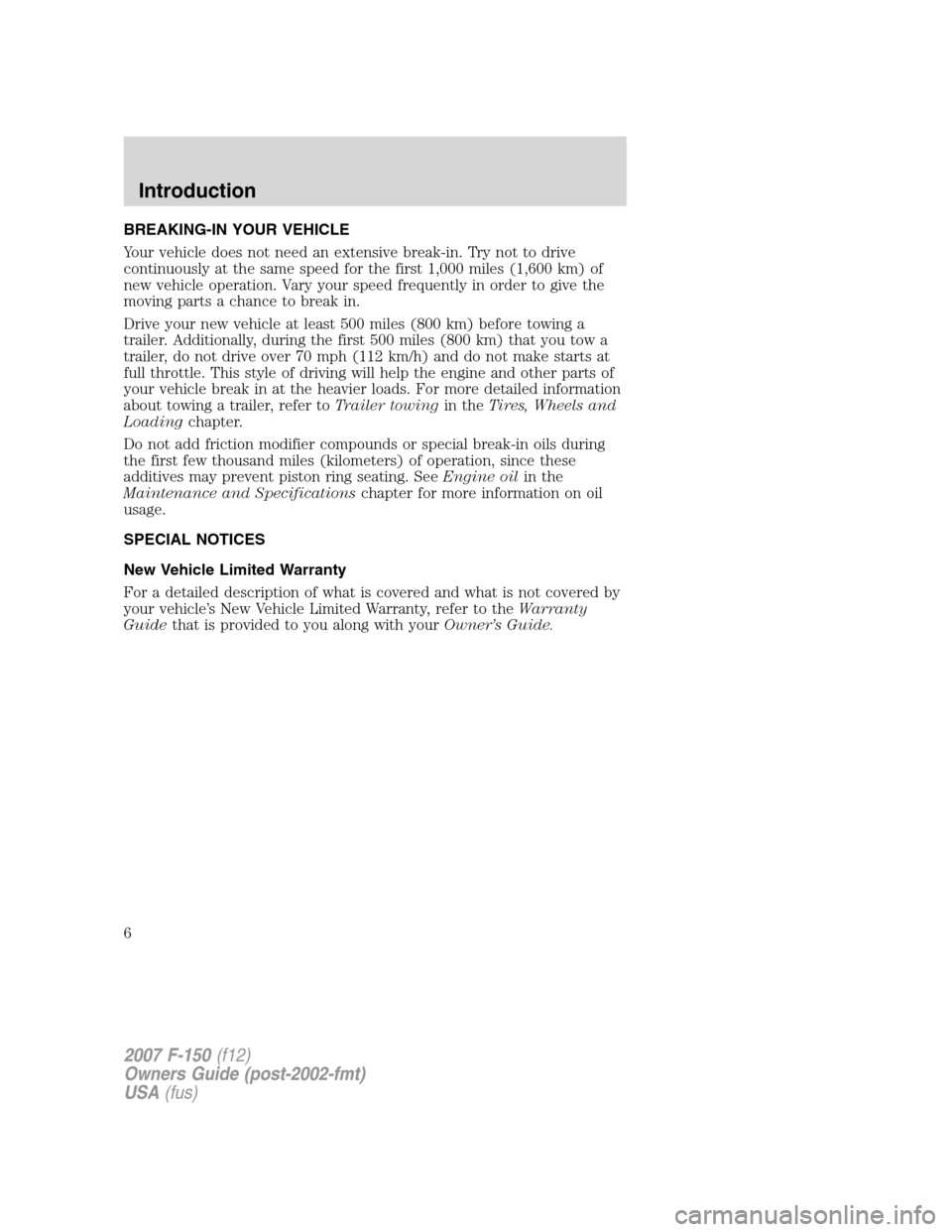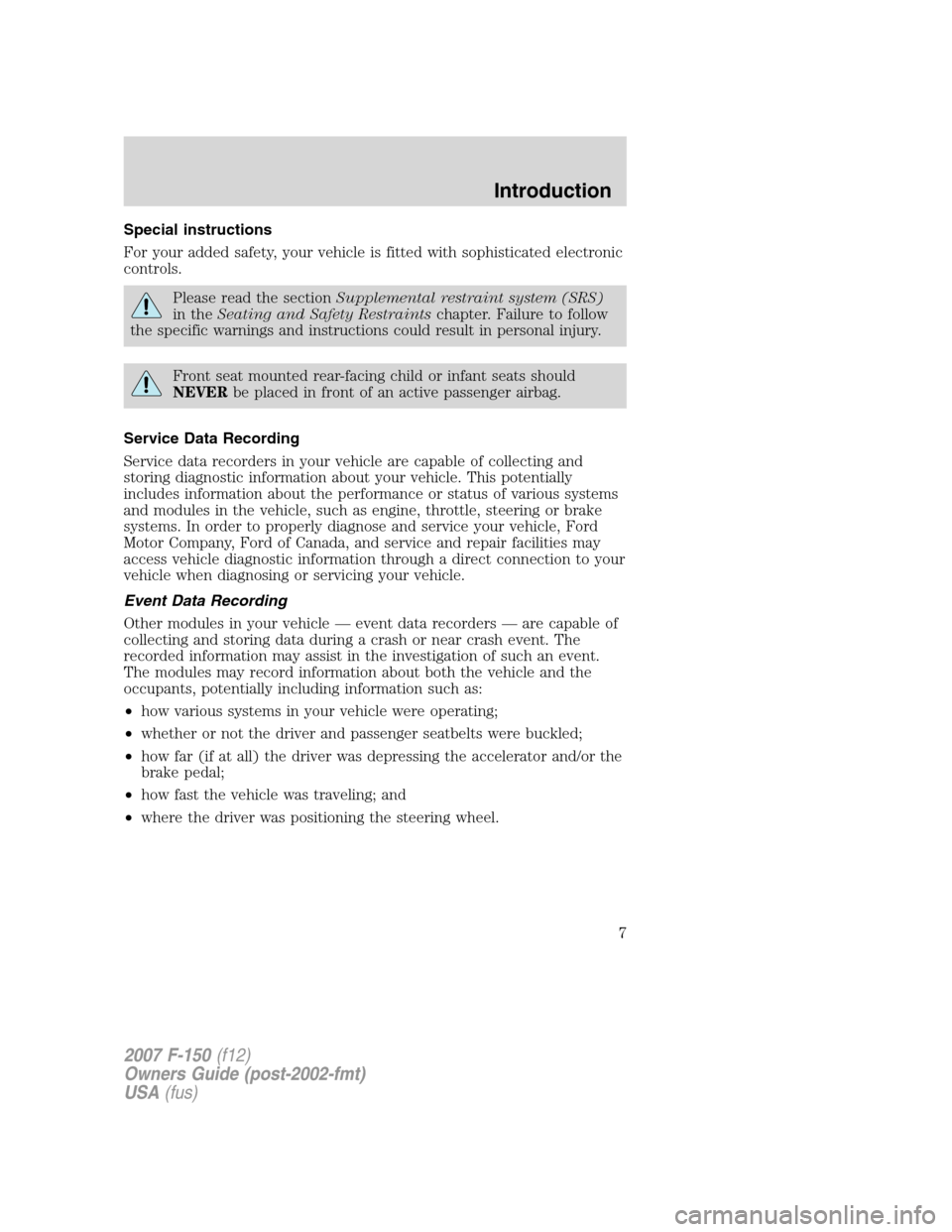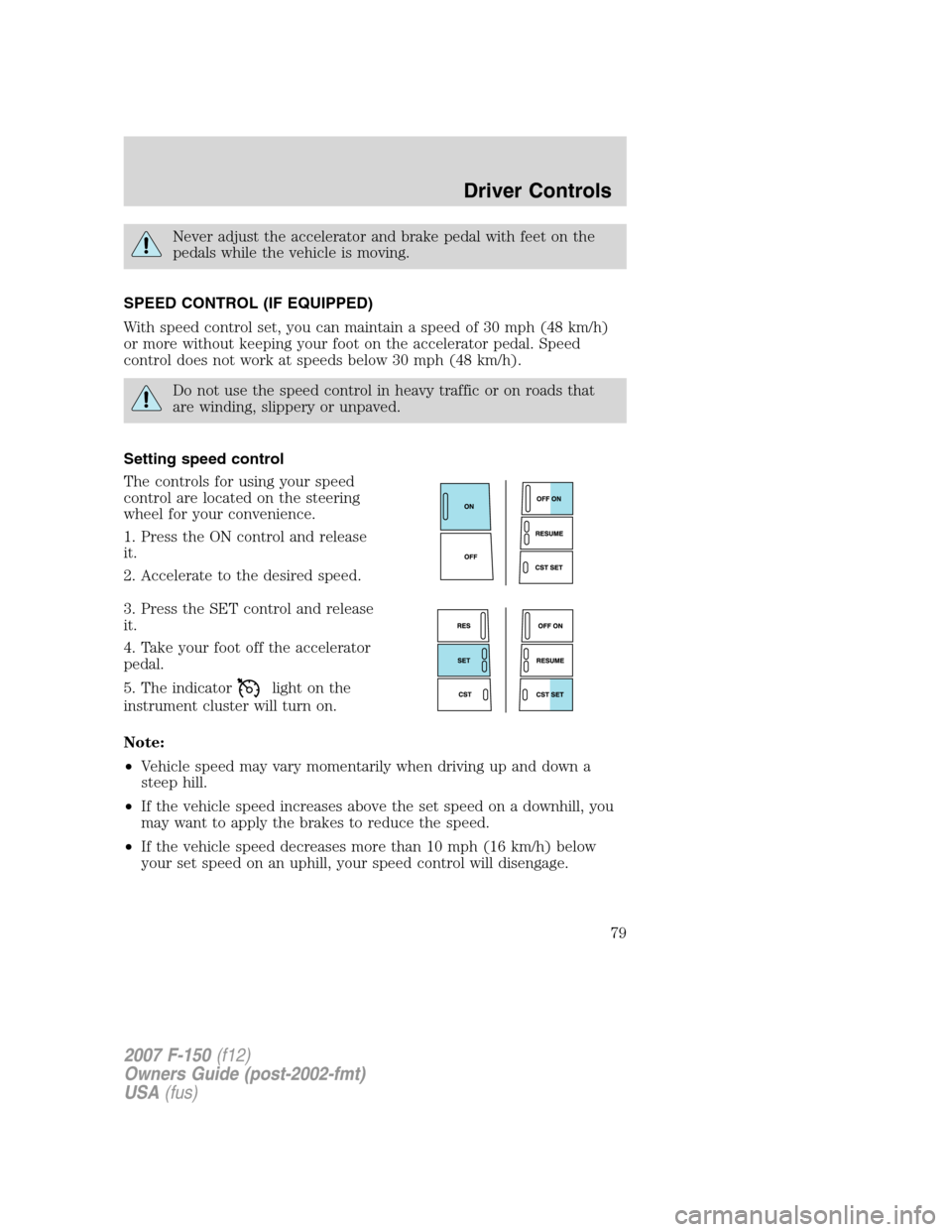Page 1 of 344
Introduction 4
Instrument Cluster 12
Warning lights and chimes 12
Gauges 19
Entertainment Systems 22
How to get going 22
AM/FM stereo 26
AM/FM stereo with CD 28
AM/FM stereo with in-dash six CD 34
Auxiliary input jack 41
Satellite radio information 45
Climate Controls 48
Heater only 48
Manual heating and air conditioning 49
Automatic temperature control 51
Rear window defroster 57
Lights 58
Headlamps 58
Turn signal control 61
Bulb replacement 63
Driver Controls 68
Windshield wiper/washer control 68
Steering wheel adjustment 68
Power windows 74
Mirrors 77
Speed control 79
Message center 89
Tailgate 98
Table of Contents
1
2007 F-150(f12)
Owners Guide (post-2002-fmt)
USA(fus)
Page 2 of 344
Locks and Security 101
Keys 101
Locks 101
Anti-theft system 112
Seating and Safety Restraints 115
Seating 115
Safety restraints 121
Airbags 140
Child restraints 149
Tires, Wheels and Loading 167
Tire information 169
Tire inflation 171
Tire Pressure Monitoring System (TPMS) 184
Vehicle loading 188
Trailer towing 194
Recreational towing 206
Driving 208
Starting 208
Brakes 212
Traction Control™ 215
Transmission operation 217
Roadside Emergencies 241
Getting roadside assistance 241
Hazard flasher switch 243
Fuel pump shut-off switch 243
Fuses and relays 244
Changing tires 252
Lug nut torque 259
Jump starting 259
Wrecker towing 265
Table of Contents
2
2007 F-150(f12)
Owners Guide (post-2002-fmt)
USA(fus)
Page 6 of 344

BREAKING-IN YOUR VEHICLE
Your vehicle does not need an extensive break-in. Try not to drive
continuously at the same speed for the first 1,000 miles (1,600 km) of
new vehicle operation. Vary your speed frequently in order to give the
moving parts a chance to break in.
Drive your new vehicle at least 500 miles (800 km) before towing a
trailer. Additionally, during the first 500 miles (800 km) that you tow a
trailer, do not drive over 70 mph (112 km/h) and do not make starts at
full throttle. This style of driving will help the engine and other parts of
your vehicle break in at the heavier loads. For more detailed information
about towing a trailer, refer toTrailer towingin theTires, Wheels and
Loadingchapter.
Do not add friction modifier compounds or special break-in oils during
the first few thousand miles (kilometers) of operation, since these
additives may prevent piston ring seating. SeeEngine oilin the
Maintenance and Specificationschapter for more information on oil
usage.
SPECIAL NOTICES
New Vehicle Limited Warranty
For a detailed description of what is covered and what is not covered by
your vehicle’s New Vehicle Limited Warranty, refer to theWarranty
Guidethat is provided to you along with yourOwner’s Guide.
2007 F-150(f12)
Owners Guide (post-2002-fmt)
USA(fus)
Introduction
6
Page 7 of 344

Special instructions
For your added safety, your vehicle is fitted with sophisticated electronic
controls.
Please read the sectionSupplemental restraint system (SRS)
in theSeating and Safety Restraintschapter. Failure to follow
the specific warnings and instructions could result in personal injury.
Front seat mounted rear-facing child or infant seats should
NEVERbe placed in front of an active passenger airbag.
Service Data Recording
Service data recorders in your vehicle are capable of collecting and
storing diagnostic information about your vehicle. This potentially
includes information about the performance or status of various systems
and modules in the vehicle, such as engine, throttle, steering or brake
systems. In order to properly diagnose and service your vehicle, Ford
Motor Company, Ford of Canada, and service and repair facilities may
access vehicle diagnostic information through a direct connection to your
vehicle when diagnosing or servicing your vehicle.
Event Data Recording
Other modules in your vehicle — event data recorders — are capable of
collecting and storing data during a crash or near crash event. The
recorded information may assist in the investigation of such an event.
The modules may record information about both the vehicle and the
occupants, potentially including information such as:
•how various systems in your vehicle were operating;
•whether or not the driver and passenger seatbelts were buckled;
•how far (if at all) the driver was depressing the accelerator and/or the
brake pedal;
•how fast the vehicle was traveling; and
•where the driver was positioning the steering wheel.
2007 F-150(f12)
Owners Guide (post-2002-fmt)
USA(fus)
Introduction
7
Page 17 of 344

Safety belt:Reminds you to fasten
your safety belt. A BeltMinder�
chime will also sound to remind you
to fasten your safety belt. Refer to
theSeating and safety restraints
chapter to activate/deactivate the BeltMinder�chime feature.
Charging system:Illuminates when
the battery is not charging properly.
Door ajar:Illuminates when the
ignition is in the ON position and
any door is open.
Low tire pressure warning (if
equipped):Illuminates when your
tire pressure is low. If the light
remains ON at start up or while
driving, the tire pressure should be
checked. Refer toInflating Your Tiresin theTires, Wheels and
Loadingchapter. When the ignition is first turned to ON, the light will
illuminate for 3 seconds to ensure the bulb is working. If the light does
not turn ON, have the system inspected by your authorized dealer. For
more information on this system, refer toUnderstanding Your Tire
Pressure Monitoring Systemin theTires, Wheels and Loading
chapter.
Overdrive off (if equipped):
Illuminates when the overdrive
function of the transmission has
been turned off, refer to the
Drivingchapter. If the light does not illuminate, have the transmission
serviced soon, or damage may occur.
Traction Control�(if equipped):
Illuminates when the Traction
Control�is active. If the light
remains on, have the system
serviced immediately, refer to the
Drivingchapter for more
information.
O/D
OFF
2007 F-150(f12)
Owners Guide (post-2002-fmt)
USA(fus)
Instrument Cluster
17
Page 18 of 344

Four wheel drive low (if
equipped):Illuminates when
four-wheel drive low is engaged.
Four wheel drive high (if
equipped):Illuminates when
four-wheel drive high is engaged.
Speed control:Illuminates when
the speed control is activated. Turns
off when the speed control system
is deactivated.
Turn signal:Illuminates when the
left or right turn signal or the
hazard lights are turned on. If the
indicators stay on or flash faster, check for a burned out bulb.
High beams:Illuminates when the
high beam headlamps are turned on.
MINI MESSAGE CENTER WARNING DISPLAYS (IF EQUIPPED)
Door ajar:Displays when the
ignition is in the ON position and
any door is open.
Low fuel:Displays when the fuel
level in the fuel tank is at or near
empty (refer toFuel gaugein this
chapter).
Check fuel cap:Displays when the
fuel cap may not be properly
installed. Continued driving with
this display on may cause the
Service engine soon warning light to
come on. Refer toFuel filler capin theMaintenance and
Specificationschapter.4x4
LOW
4x4 HI
2007 F-150(f12)
Owners Guide (post-2002-fmt)
USA(fus)
Instrument Cluster
18
Page 68 of 344

MULTI-FUNCTION LEVER
Windshield wiper:Rotate the end
of the control away from you to
increase the speed of the wipers;
rotate towards you to decrease the
speed of the wipers.
Windshield washer:Push the end
of the stalk:
•briefly: causes a single swipe of
the wipers without washer fluid.
•a quick push and hold: the wipers
will swipe three times with
washer fluid.
•a long push and hold: the wipers and washer fluid will be activated for
up to ten seconds.
Note:Do not operate the washer when the washer reservoir is empty.
This may cause the washer pump to overheat. Check the washer fluid
level frequently. Do not operate the wipers when the windshield is dry.
This may scratch the glass, damage the wiper blades and cause the wiper
motor to burn out. Before operating the wiper on a dry windshield,
always use the windshield washer. In freezing weather, be sure the wiper
blades are not frozen to the windshield before operating the wipers.
TILT STEERING WHEEL (IF EQUIPPED)
Pull the lever down to unlock the
steering column. While the lever is
in the down position, tilt the
steering column to its desired
orientation.
2007 F-150(f12)
Owners Guide (post-2002-fmt)
USA(fus)
Driver Controls
68
Page 79 of 344

Never adjust the accelerator and brake pedal with feet on the
pedals while the vehicle is moving.
SPEED CONTROL (IF EQUIPPED)
With speed control set, you can maintain a speed of 30 mph (48 km/h)
or more without keeping your foot on the accelerator pedal. Speed
control does not work at speeds below 30 mph (48 km/h).
Do not use the speed control in heavy traffic or on roads that
are winding, slippery or unpaved.
Setting speed control
The controls for using your speed
control are located on the steering
wheel for your convenience.
1. Press the ON control and release
it.
2. Accelerate to the desired speed.
3. Press the SET control and release
it.
4. Take your foot off the accelerator
pedal.
5. The indicator
light on the
instrument cluster will turn on.
Note:
•Vehicle speed may vary momentarily when driving up and down a
steep hill.
•If the vehicle speed increases above the set speed on a downhill, you
may want to apply the brakes to reduce the speed.
•If the vehicle speed decreases more than 10 mph (16 km/h) below
your set speed on an uphill, your speed control will disengage.
2007 F-150(f12)
Owners Guide (post-2002-fmt)
USA(fus)
Driver Controls
79